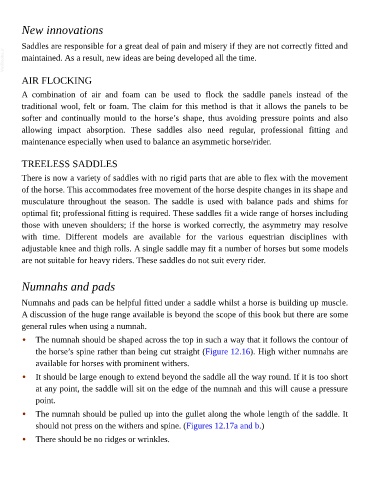Page 557 - The Veterinary Care of the Horse
P. 557
New innovations
Saddles are responsible for a great deal of pain and misery if they are not correctly fitted and
VetBooks.ir maintained. As a result, new ideas are being developed all the time.
AIR FLOCKING
A combination of air and foam can be used to flock the saddle panels instead of the
traditional wool, felt or foam. The claim for this method is that it allows the panels to be
softer and continually mould to the horse’s shape, thus avoiding pressure points and also
allowing impact absorption. These saddles also need regular, professional fitting and
maintenance especially when used to balance an asymmetic horse/rider.
TREELESS SADDLES
There is now a variety of saddles with no rigid parts that are able to flex with the movement
of the horse. This accommodates free movement of the horse despite changes in its shape and
musculature throughout the season. The saddle is used with balance pads and shims for
optimal fit; professional fitting is required. These saddles fit a wide range of horses including
those with uneven shoulders; if the horse is worked correctly, the asymmetry may resolve
with time. Different models are available for the various equestrian disciplines with
adjustable knee and thigh rolls. A single saddle may fit a number of horses but some models
are not suitable for heavy riders. These saddles do not suit every rider.
Numnahs and pads
Numnahs and pads can be helpful fitted under a saddle whilst a horse is building up muscle.
A discussion of the huge range available is beyond the scope of this book but there are some
general rules when using a numnah.
• The numnah should be shaped across the top in such a way that it follows the contour of
the horse’s spine rather than being cut straight (Figure 12.16). High wither numnahs are
available for horses with prominent withers.
• It should be large enough to extend beyond the saddle all the way round. If it is too short
at any point, the saddle will sit on the edge of the numnah and this will cause a pressure
point.
• The numnah should be pulled up into the gullet along the whole length of the saddle. It
should not press on the withers and spine. (Figures 12.17a and b.)
• There should be no ridges or wrinkles.

